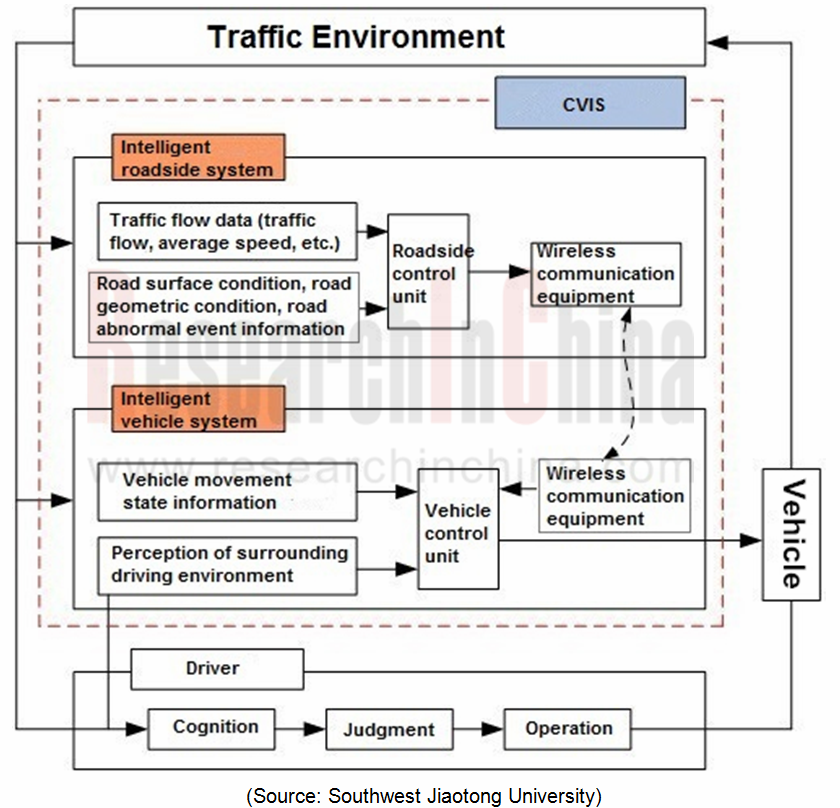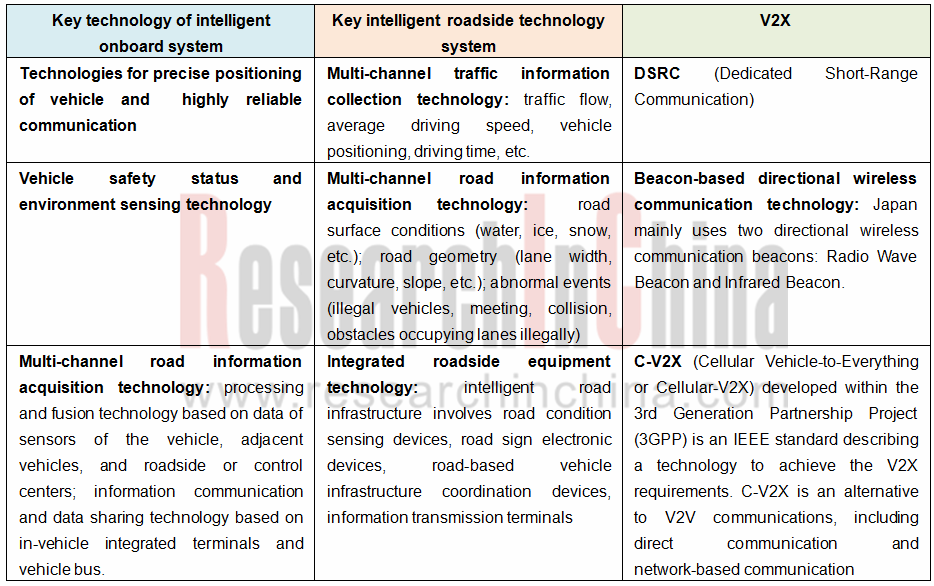Cooperative Vehicle Infrastructure System (CVIS) and Vehicle to Everything (V2X) Industry Report, 2018
Autonomous driving fuses emerging technologies in many industries, and springs up with combinations of new technologies, solutions and products. Cellular vehicle-to-everything (C-V2X) and cooperative vehicle infrastructure system (CVIS) as the two most valued technologies expectedly boomed last year.
Preparing the report brings us back to the development course of personal digital assistant (PDA) and cellphone industry as we are a research institution experiencing how cellphones become intelligent.
There was a melee between PDA and PDA cellphone before iPhone. Palm was the first one sought after by numerous PDA-fanciers who voluntarily wrote evaluation reports and organized fan exchange clubs for the firm, an echo to today’s Tesla.
Many independent operating system developers and open API-based PDA and cellphone vendors (like Nokia) which were active players in the market, then disappeared. These days some OEMs are either developing operating systems by themselves or open software/hardware interfaces. Emerging car manufacturing forces mushroom as herds of cellphone knockoffs did in those years. History does often rhyme.
Without doubt, car manufacturing differs a lot from cellphone industry for its industry scale and complexity more than ten times larger, so it is not quite right to draw a full analogy between them.
Apple’s APPSTORE model, the built 2.5G/3G/4G wireless data networks and the unified smartphone operating systems (with developers reduced to 2 or 3 from dozens) served as a premise of the subsequent prosperity, application and service expansion of mobile internet. Intelligent vehicle industry is probable to follow suit.
IT firms that foray into car manufacturing initially made fun of automakers by saying they still lived in “primitive society” in applying IT and they followed the beaten track with so low efficiency -- even the most intelligent vehicle still lagged behind smartphone by generations in terms of connectivity.
The truth is that chip computing, network transmission and infrastructure still fall short of basic requirements of automobile industry, and intelligent and connected trends of cars still have not been pushed ahead on a gigantic scale.
Connected car alone is little more than a “top student” with high IQs but low EQs.
Connected cars that can only predict intentions of other road users without communicating with surroundings, just act like a “straight-A student” who is a low EQ intellectual performing well on campus (simple traffic scene) but probably falling flat in society (complicated traffic scene).
Human drivers can communicate with pedestrians by expression in their eyes and gestures when crossing an intersection with no traffic signals, through which both drivers and pedestrians can know who will go first. Automated vehicles are however incapable of intentional communication in spite of sensors.
Traffic environment is quite complex and changeable, especially in China where several traffic scenes co-exist under mixed traffic flow. Current automated vehicles have yet to experience so many scenes to travel safely that commercialization of connected cars is faced with high risks.
If wanting to well know intentions of other traffic participants, connected cars undoubtedly need to communicate with them and surroundings. CVIS and V2X then play a key part.
Advantages of CVIS
Cooperative vehicle-infrastructure system (CVIS) can acquire vehicle and road information by use of wireless communication and sensor detection technologies, allowing interaction and data sharing between vehicles, between vehicles and infrastructures. The system is a good solution to intelligent communication and coordination between vehicles and infrastructures, making system resources used in a more efficient way, enabling safer road traffic and reducing traffic jams. CVIS is a new trend for intelligent transportation system (ITS).

CVIS is an interaction that interprets the intentions of traffic participants with great precision. It not only guesses what the car is going to do, but also perceives the situation accurately, so that it can make correct judgments.
In addition to interactive capabilities, CVIS can substantially improve perception of autonomous vehicles. Vision, radar, LiDAR and other sensors can be mounted on cars and street light poles which evolve into all-in-one signal poles, all-in-one traffic poles, and all-in-one electric alarm poles. The simultaneous perception of cars and road terminals can minimize blind zones and notify the collision out of sight in advance.
Road terminals deliver enough instructions and suffice the decision-making of autonomous vehicles whose complexity will be reduced remarkably and costs will get much lowered because they need not go through all scenarios. Accordingly, autonomous driving will be earlier commercialized than expected.
In addition to the perception and communication facilities at cars and roads, Ministry of Transport of the People's Republic of China (MOT) is planning to transform roads into intelligent ones and suit them for autonomous driving.
In February 2018, Ministry of Transport issued Notice of MOT’s General Office on Accelerating the Next-Generation National Traffic Control Network and Smart Highway Pilots, proposing to focus on traffic control network and smart roads, involving: (1) digitalization of infrastructure, (2) integrated road transport CVIS, (3) synthetic application of Beidou high-precision positioning, (4) integrated management of road network based on big data, (5) “Internet +” road network integrated services, (6) the new generation of national traffic control network. It is decided in the Notice that smart road trials will accelerate to be carried out in provinces including Beijing, Hebei, Jilin, Jiangsu, Zhejiang, Fujian, Jiangxi, Henan, and Guangdong.
CVIS has just emerged, while the race in autonomous driving enters the second half.
Intelligent Transportation Systems (ITS) has been developing for many years. As the advanced stage of ITS, CVIS deals with technologies such as intelligent onboard system technology, intelligent road test technology, and V2X.

Intelligent onboard system technology and automotive intelligent technology have great common ground, but the perception of the road surface partly depends on the road test unit.
In short, the “smart cars + intelligent roads + CVIS” eligible for fully autonomous driving has just begun. Despite the automotive intelligence of giants like Waymo and Tesla grows mature, it is still far away from fully autonomous driving. The competition in autonomous driving is ushering in the second half when infrastructure will get improved and the market space for car manufacturing will be narrowing, while the market of operations, applications and services will be developing apace.
Competitiveness will be increasingly shown from such technical capabilities as chassis control, sensing systems, chips, power batteries, communication systems, artificial intelligence, intelligent roads, CVIS, big data, cloud computing, etc., and cross-industry competition and cooperation will be an forever subject.
In the second half, most small- and medium-sized enterprises will have to give in to giants (such as Velodyne) with strong core competencies. It is crucial to choose a reliable technical route, because a variety of embedded LINUXs in the early stage of smart phones vanished long ago; it is very important to define the appropriate product positioning, because core parts suppliers outlive vendors of complete machines; it is vital to keep abreast of the developments in the industry since the complexity and scope of the autonomous driving industry is far beyond imagination and new competitors flock to the industry all the time.
As abovementioned, Tesla, who temporarily goes ahead of others, may not be able to take the lead for a long time. Powerful Huawei, Apple and other giants have not yet exerted themselves utterly, which means the second half of autonomous driving contest has just kicked off.
Global and China Leading Tier1 Suppliers’ Intelligent Cockpit Business Research Report, 2022 (II)
Tier1 Intelligent Cockpit Research: The mass production of innovative cockpits gathers pace, and penetration of new technologies is on a rapid riseGlobal OEMs and Tier 1 suppliers are racing for the i...
Global and China Leading Tier1 Suppliers’ Intelligent Cockpit Business Research Report, 2022 (I)
Tier1 Intelligent Cockpit Research: The mass production of innovative cockpits gathers pace, and penetration of new technologies is on a rapid riseGlobal OEMs and Tier 1 suppliers are racing for the i...
China Commercial Vehicle Intelligent Cockpit Industry Report 2021
Research on Intelligent Cockpits of Commercial Vehicles: Heading for Large Screens, Voice Interaction, Entertainment and Life
Following AD/ADAS functions, the intelligent configuration of the cockpit...
Automotive Ultra Wide Band (UWB) Industry Report, 2022
UWB got initially utilized in the military field, and began to be commercially applied after the release of criteria for UWB commercialization in 2002. In 2019, Car Connectivity Consortium (CCC) liste...
China Automotive Distribution and Aftermarket Industry Report, 2022-2027
Since the introduction of 4S store model into China at the end of 20th century, China's authorized dealer system has gradually developed from a single-store-based mode to a group-based mode, and from ...
Global and China Skateboard Chassis Industry Report, 2021-2022
Research into skateboard chassis: where to sell, how to sell and to whom it is sold
Rivian, a new carmaker based on skateboard chassis, is quite popular in the market and becomes the focus of the aut...
Emerging Automakers Strategy Research Report, 2022--NIO
Research on emerging carmaking strategies: no new cars in 2021, 3 new cars in 2022, can NIO make its renaissance?
The delivery of ET7 is imminent, and the sluggish sales situation is expected to fade...
Automotive and 5G Industry Integration Development Report, 2022
Research on integration of vehicle and 5G: OEMs rush into mass production of 5G models whose sales may reach 3.68 million units in 2025
By the end of 2021, China had built and opened in excess of 1.3...
China Automotive Finance Industry Report, 2022-2030
Auto finance is lucrative with the highest profit margin in the international automobile industry chain, contributing to roughly 23% of the global automobile industry profits. Yet, auto finance only h...
Global and China Power Battery Management System (BMS) Industry Report, 2022-2026
1. Robust demand from new energy vehicle spurs BMS market to boom
New energy vehicle sales have been growing rapidly worldwide over the recent years, reaching 6.5 million units with a year-on-year up...
ADAS/AD Chip Industry Research Report, 2022
Autonomous driving chip research: In addition to computing power, core IP, software stacks, AI training platforms, etc. are becoming more and more importantL2.5 and L2.9 have achieved mass production ...
Automotive Sensor Chip Industry Research Report, 2022
Sensor Chip Research: Automotive Sensors Have Entered a Technology Iteration Cycle, and Opportunities for Localization of Chips Are Coming Automotive sensor chips can obtain external environment ...
Automotive Cloud Service Platform Industry Report, 2021-2022
Research on Automotive Cloud Services: Based on 5ABCD, cloud services run through the R&D, production, sale, management and services of automakersWith the development of intelligent connectivity, ...
Global and China Cobalt Industry Report, 2021-2026
As a very rare metal and an important strategic resource for a country, cobalt gets typically utilized in battery materials, super heat-resistant alloys, tool steels, cemented carbides, and magnetic m...
Automotive Event Data Recorder (EDR) Industry Report, 2022
An event data recorder (EDR), sometimes referred to informally as an automotive black box, is a device or a system installed in vehicle to monitor, collect and record technical vehicle data and occupa...
Commercial Vehicle ADAS Industry Report, 2021
ResearchInChina has published the "Commercial Vehicle ADAS Industry Report, 2021", focusing on policy climate, ADAS installations, suppliers, etc., and with a deep dive into the prospects of Chinese c...
Automotive High-precision Positioning Research Report, 2022
High-precision Positioning Research: from L2+ to L3, high-precision integrated navigation and positioning will become the standard
With the development and progress of the autonomous driving industry...
China Around View System (AVS) Suppliers and Technology Trends Report, 2021 –Joint Venture Automakers
Research into JV automakers’ around view system: large-scale implementation of AVP is round the corner, and AVS vendors are energetically pushing ahead with parking fusion solution.
During January to...